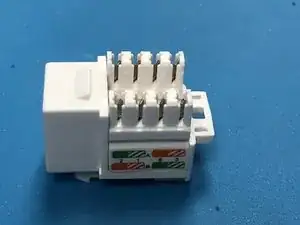
How to Wire a RJ-45 KeyStone Jack
These are some common tools used to work on this device. You might not need every tool for every procedure.
Ethernet cables are cables which carry data within a network. If your computer has an Ethernet jack (modern slim computers often don’t, but you can buy an adapter) you can connect the device directly to your home or office network using an Ethernet cable. One end of the cable goes into your computer; the other end plugs into a matching socket usually located on the wall. Since a huge number of devices can now connect to a network using fancy Wi-Fi, you might wonder why anyone would use Ethernet cables anymore. There’s a few upsides at the cost of an annoying downside:
The other limiting factor of Ethernet is that you need to have access to an Ethernet outlet. Most routers have a few Ethernet ports which you can use directly, but you might need a pretty long cable if you want to connect your computer to a router located on the other side of the building. If you have the time and patience, an alternative solution is to install Ethernet cables through your walls. This is the method used in many offices and newer homes which have the installation done during construction. This video on YouTube provides a good overview of the process of installing Ethernet cable in pre-existing walls.
Another important consideration with regard to Ethernet cables is the type of cable you use during installation or to connect your computer directly. You see, the phrase “Ethernet cable” is technically a misnomer. Ethernet itself is a generic method of communication; the data that is transferred via Ethernet can move along a number of different cables such as fiber-optic cables or coaxial cables (the same type used for antennas or radios). The oldest Ethernet setups used coaxial cables, while the newest high-speed applications use fiber-optic cables. In a standard environment, however, Ethernet is transferred over a cable containing pairs of twisted wires.
While this distinction is fairly pedantic, knowing the difference might save you from an attack by the IT gods.
There are several different standards for twisted pair Ethernet cabling, which define the maximum data transfer rates, distance limitations, and other specifications. Here is a roundup of the most common twisted pair Ethernet cabling standards:
In addition to these standards, there are also several other variations and sub-standards that offer different capabilities and specifications. For example, Cat5e and Cat6 are available in shielded and unshielded versions, which provide different levels of protection against electromagnetic interference (EMI). It's important to select the right type of cabling based on the specific requirements of your network.
See this nice ElectronicsNotes article for more information on each category cable. If you’re looking at a cable you already have, you can identify the category by looking for small text printed on the outside of the cable. As shown in this trueCable article, the side of the cable will have information such as the category included in this small text.